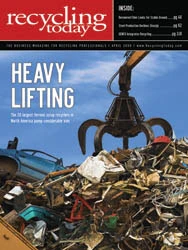A REAL DOWNER
What has been a difficult market for ferrous scrap recyclers did not get any easier in the March buying period, as pricing fell further, flows into yards diminished and outbound sales were difficult to find for some processors.
On average, spot buyers in March paid about $20 per ton less for ferrous scrap, according to transaction pricing compiled by Management Science Associates Inc. (MSA) for its Raw Material Data Aggregation Service (RMDAS).
The national averages compiled through RMDAS showed mills nationally paying $20 per ton less for prompt industrial grades ($208 vs. $228) and $19 per ton less for No. 2 shredded scrap, defined as .17 or more copper content ($201 vs. $220).
No. 1 heavy melting steel (HMS) lost less of its value, dropping $16 per ton in value nationally in the spot market and losing just $3 per ton in value in the South region (which includes Texas, Oklahoma, Louisiana, Arkansas, Mississippi, Tennessee, Alabama, Georgia, Florida, South Carolina and parts of North Carolina and Virginia).
Regionally, scrap sellers in the North Midwest noticed the sharpest decline, with industrial grades falling $29 per ton and No. 2 shredded scrap dropping by $30 per ton.
As of mid-March, recyclers say they continue to see slack demand and weak pricing shaping up for April.
A scrap processor in the South received very few offers to buy ferrous scrap in the March buying period and says he sees April shaping up similarly. "I’m just selling a piddling amount of scrap and at a very poor price," he comments. "And I think April is going to be even worse than March."
The recycler, who is with an independent family-owned company, also says he suspects that North American steelmakers who own their own scrap recycling subsidiaries are purchasing from those subsidiaries, leaving the independent companies with even lighter demand.
"I think it’s a big mistake that will rectify itself," he comments. "What happens is, in supporting their own operations, they wind up paying more for raw material than if they had stayed with the people who brought them to the dance—people with whom they had relationships that span decades."
In the meantime, though, the cash flow of independents is troublesome, the recycler comments. "I haven’t been able to sell my ‘buy’ since July," he says.
Export markets also are weak compared to the boom years. A broker who sells containerized ferrous scrap to Asia says demand for those shipments is roughly half of what it was in 2008. "We’re still doing OK, but it’s not like it was last year."
The continued lack of demand was reflected in statistics kept domestically and globally.
In the United States during the week of March 10-14, raw steel production was 976,000 net tons, and the capability utilization rate of mills was just 40.9 percent.
Those figures reflect a dramatic difference from activity one year ago, when domestic weekly steelmaking production stood at more than 2.1 million tons in the week ending March 14, 2008, reflecting a capability utilization rate of 89.7 percent.
The 54.4 percent year-against-year weekly production decline serves to demonstrate the lack of demand for finished steel in 2009. Those looking for a rebound have not seen it as of mid-March, as figures for the week of March 14, 2009, were down 6 percent from the previous week, when production was slightly more than 1 million tons.
Globally the decline is not quite as dramatic, but is significant nonetheless. World crude steel production in February 2009 for the 66 countries reporting to the World Steel Association (Worldsteel) was 84 million metric tons, a figure that is 22 percent lower than the figure for February 2008.
Worldwide, "crude steel production showed a continued decrease in nearly all the major-steel producing countries in February 2009 compared to the same month [of] 2008, except [in] Iran and China," Worldsteel reports.
China’s crude steel production for February 2009 was 40.4 million metric tons, an increase of 4.9 percent compared to February 2008. Not all of Asia was back on fast pace, however, as Japan produced 5.5 million metric tons of crude steel in February 2009, down 44 percent compared to the same month last year. Similarly, South Korea showed a decrease of nearly 25 percent compared to February 2008.
Weakness in the U.S. economy was reflected by domestic production of just 3.8 million metric tons of steel in February 2009, a decrease of more than 54 percent compared to the same month last year.
(Additional news about ferrous scrap, including breaking news and consuming industry reports, is available online at ww.RecyclingToday.com.)

Explore the April 2009 Issue
Check out more from this issue and find your next story to read.
Latest from Recycling Today
- Aqua Metals secures $1.5M loan, reports operational strides
- AF&PA urges veto of NY bill
- Aluminum Association includes recycling among 2025 policy priorities
- AISI applauds waterways spending bill
- Lux Research questions hydrogen’s transportation role
- Sonoco selling thermoformed, flexible packaging business to Toppan for $1.8B
- ReMA offers Superfund informational reports
- Hyster-Yale commits to US production





